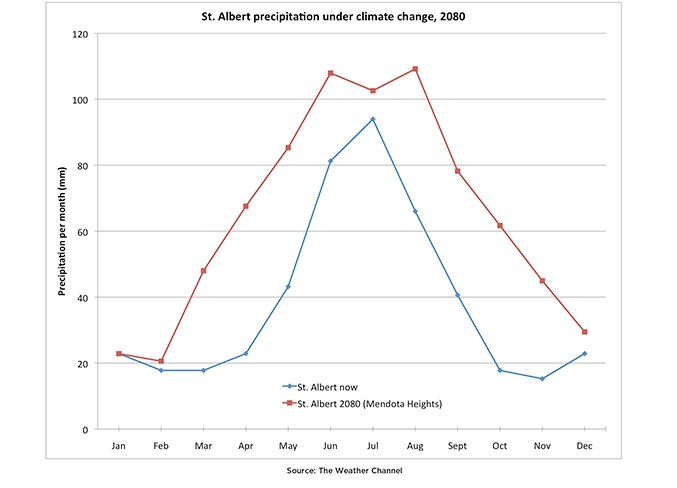St. Albert’s summers will be a lot like those in Mendota Heights, Minnesota, in 2080 due to climate change, a new study suggests.
Ecologist Matthew Fitzpatrick of the University of Maryland Centre for Environmental Science published a study this week in Nature Communications that used climate analogue mapping to illustrate what North American climates will look like in 2080 under climate change.
Research suggests there’s a gap between the studies scientists do on climate change and public understanding of them, Fitzpatrick said. Most climate models project the world is on track to see 5 C of warming by the end of this century, for example.
“I don’t know about you, but that number doesn’t really mean anything to me,” Fitzpatrick said.
The study took 540 North American cities representing some 250 million people, forecast how their temperature and precipitation would change in 60 years under a business-as-usual and strong greenhouse gas reduction scenario, and paired them with cities that had such climates today. Fitzpatrick then compiled the results into a web app (https://tinyurl.com/urbanclimate).
The study did not specifically look at St. Albert, but Fitzpatrick said the results for here would be pretty close to the ones for Edmonton.
The study found most cities had to look about 850 kilometres to the south to find their future climate analogue under the business-as-usual scenario, compared to just 514 kilometres for the sharp reductions one.
Without sharp cuts to emissions, the study found Edmonton and St. Albert’s climate in 2080 would be like that of Mendota Heights, Minnesota, today, the summers of which were 5.5 C warmer and 28.7 per cent wetter than those here.
Data from The Weather Channel shows Mendota Heights also gets two to three times as much rain as St. Albert in many months and can get as hot as 42.2 C in July.
It’s important to note these are monthly averages, which mask the big swings in weather we’ll get under climate change, said Joel Nodelman, a St. Albert engineer who has worked in climate change risk management for some 15 years.
“The weather is going to be strange. It’s going to be extreme. It’s going to be unpredictable.”
And since we build roads, sewers and structures on the assumption that tomorrow’s climate will be like yesterday’s, that’s a problem, Nodelman continued. Engineers build in wiggle-room, but the question is if they put in enough to handle these changes.
“Typically the way we find out that it’s not enough is when we flood Perron Street,” he said, referring to a 2008 downpour that set cars floating in the Grandin mall parking lot.
Fitzpatrick said he was surprised to see the climate in his hometown of Cumberland, Maryland, was on course to become more like southern Kentucky due to climate change.
“As someone who likes winter sports and cold weather, I was dismayed to see that.”
City of St. Albert environment manager Christian Benson said this study could give residents a tangible way to look at what’s coming down the pipe for climate change. City officials might want to talk to their Mendota Heights counterparts for insight on how they build their roads and sewers.
St. Albert’s climate shift would be less dramatic if it made significant cuts to emissions. Under the strong-reduction scenario, Fitzpatrick found Edmonton and St. Albert’s future climate would be more like that of Alexandria, Minnesota, the summers for which are 3.9 C warmer and 17.6 per cent wetter than here.
Canadians need to burn less fossil fuel if they want to minimize the scale of climate change they’ll face in years ahead, Nodelman said.
“The fewer emissions you generate, the less weird (climate change) is going to be.”
Fitzgerald’s study is available at go.nature.com/2E6pyqA.




